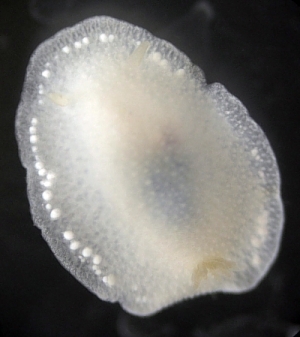
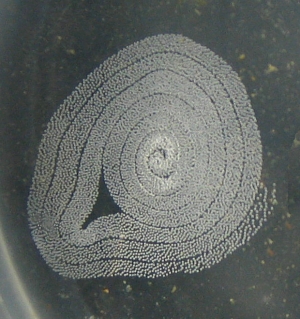
Conualevia alba
Collier and Farmer, 1964
Order: NUDIBRANCHIA
Suborder: DORIDINA
Superfamily: EUDORIDOIDEA
Family: Conualevidae
DISTRIBUTION
Eastern Pacific from from Monterey, California south to the Galapagos Islands.
PHOTO
Locality: Monterey, 7 m, California, USA, Pacific Ocean, October 2006, subtidal. Length: 11 mm. Photographer: Jeff Goddard.
This species ranges from Monterey, California, south to the Galapagos Islands, and is usually found under rocks, where it preys on unidentified demosponges (personal observations). It has smooth, tapering rhinophores, small, evenly spaced notal papillae, and large white defensive glands around the notal margin. Like some other dorids consistently found feeding under rocks (e.g. Crimora coneja and Limacia cockerelli), it lays its thin egg ribbon flat, rather than on edge like most other dorids. The eggs averaged about 89 microns in diameter and hatched as typical planktotrophic veligers with shells about 150 microns long.
-
Behrens, D. W. & A. Hermosillo. (2005). Eastern Pacific nudibranchs. Sea Challengers, Monterey, California
-
Collier, C. L. & W. M. Farmer. (1964). Additions to the nudibranch fauna of the east Pacific and the Gulf of California. Transactions of the San Diego Natural History Society, 13, 377-396.
-
Camacho-Garcia, Y., T. M. Gosliner & A. Valdes. (2005). Field Guide to the sea slugs of the tropical eastern Pacific. California Academy of Sciences, San Francisco, California.
Goddard, J.H.R., 2007 (March 21) Conualevia alba Collier and Farmer, 1964 . [In] Sea Slug Forum. Australian Museum, Sydney. Available from http://www.seaslugforum.net/find/conualba
Related messages
Elongate polar bodies of Conualevia alba
March 22, 2007
From: Jeff Goddard
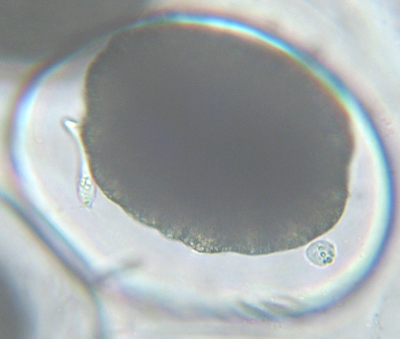
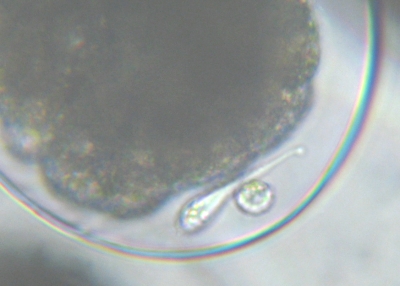
Hi Bill,
Here are some images of a bizarre developmental phenomenon I've never observed before. At about the time of gastrulation, a majority of the polar bodies of Conualevia alba elongate, stretching from their original spherical shape and diameter of about 8 - 10 microns, to 35 microns in length, and in one case, to 73 microns.
Locality: Monterey Bay, California, USA, Pacific Ocean, October 2006. Photographer: Jeff Goddard.
This is pure speculation, but it's as if the polar bodies parallel the activity of the micromeres during gastrulation, but unconfined by neighboring cells, grow these tendrils. I have no idea what the significance of this is - if there is any at all - but did observe it in the two out of two egg masses; perhaps it will interest a developmental biologist.
I found one mention in the literature of this for a nudibranch. Trinchese (1880) described a similar phenomenon in the aeolid Cuthona caerulea.
-
Trinchese, S. (1880). I primi momenti dell'evoluzione nei Molluschi. Atti della Reale Accademia dei Lincei Memorie ser 3. 7, 3-54.
Best wishes,
Jeff
goddard@lifesci.ucsb.edu
Goddard, J.H.R., 2007 (Mar 22) Elongate polar bodies of Conualevia alba. [Message in] Sea Slug Forum. Australian Museum, Sydney. Available from http://www.seaslugforum.net/find/19684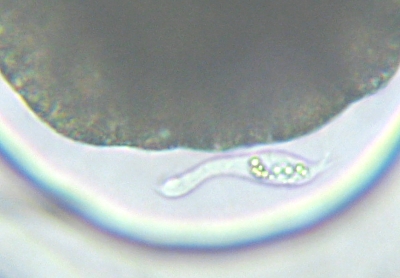
Thanks Jeff,
Bill Rudman
Conualevia alba from Monterey, California
March 22, 2007
From: Jeff Goddard
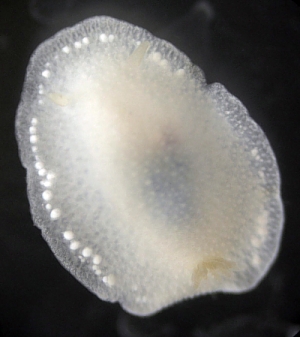
Hi Bill,
Here are some photos of Conualevia alba Collier and Farmer, 1964 collected by Anthony Draeger last October from 7 m depth off Monterey, California. This species ranges from Monterey south to the Galapagos Islands, and is usually found under rocks, where it preys on unidentified demosponges (personal observations). It has smooth, tapering rhinophores, small, evenly spaced notal papillae, and large white defensive glands around the notal margin. Like some other dorids consistently found feeding under rocks (e.g. Crimora coneja and Limacia cockerelli ), it lays its thin egg ribbon flat, rather than on edge like most other dorids. The eggs averaged about 89 microns in diameter and hatched as typical planktotrophic veligers with shells about 150 microns long. In a separate message [#19684 ] I describe this species' unusual, elongate polar bodies.
Locality: Monterey, 7 m, California, USA, Pacific Ocean, October 2006, subtidal. Length: 11 mm. Photographer: Jeff Goddard.
- Behrens, D. W. & A. Hermosillo. (2005). Eastern Pacific nudibranchs. Sea Challengers, Monterey, California
- Collier, C. L. & W. M. Farmer. (1964). Additions to the nudibranch fauna of the east Pacific and the Gulf of California. Transactions San Diego Society Natural History 13, 377-396.
- Camacho-Garcia, Y., T. M. Gosliner & A. Valdes. (2005). Field Guide to the sea slugs of the tropical eastern Pacific. California Academy of Sciences, San Francisco, California.
Best wishes,
Jeff
goddard@lifesci.ucsb.edu
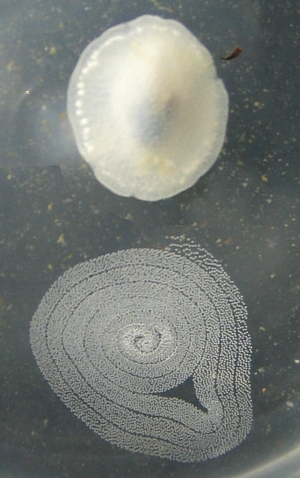
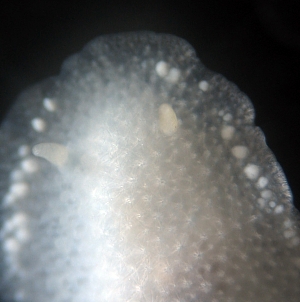
Thanks Jeff,
Bill Rudman
